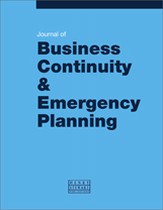Business impact analysis: Keeping critical impact in perspective
Abstract
Business impact analysis (BIA) is a relatively new science. Widely recognised standards and best practices have not yet evolved. There is a great deal of debate about both what a BIA should include and how it should be performed. However, defining ‘critical impact’ and then determining how to keep that definition in perspective is essential to any BIA process. This paper leads the reader through key considerations regarding how the BIA itself can determine what is truly critical, keep the definition of critical impact in perspective for the institution as a whole, and continuously adjust the definition of critical impact to the dynamics of an ever-changing institution.
The full article is available to subscribers to the journal.
Author's Biography
Barry Cardoza has over 30 years’ experience in business management, business process analysis and continuous process improvement within diverse industries, including retail office supply, books, lawn and garden wholesale, and even theatrical production. His experience also includes over 16 years within the banking industry. Barry is currently responsible for the Union Bank of California, NA business continuity strategy, policy, compliance and programme implementation. He chairs the Bay Area Response Coalition, a coalition of financial institutions seeking to work with each other and the public sector towards increased crisis preparedness and response. He is on the steering committee for the Southern California Financial Institutions Recovery Coalition and an appointee to the Board of Directors of the Business Resumption Managers Association. He contributes papers on a variety of technical and non-technical topics and is a frequent presenter at both regional and national conferences.
Citation
Cardoza, Barry (2006, September 1). Business impact analysis: Keeping critical impact in perspective. In the Journal of Business Continuity & Emergency Planning, Volume 1, Issue 1. https://doi.org/10.69554/UHQF5454.Publications LLP
